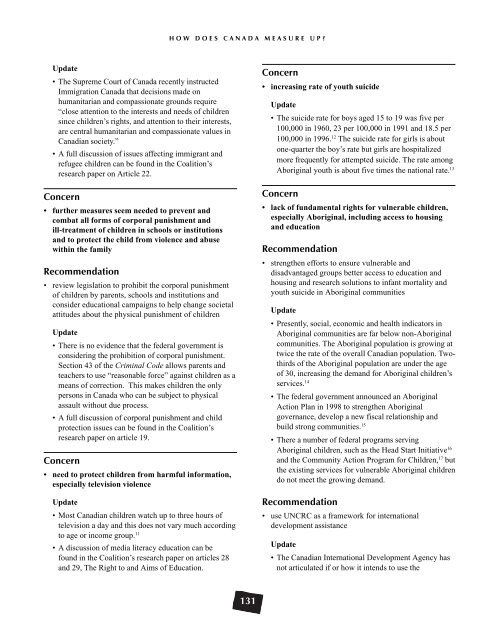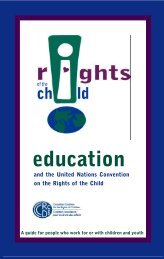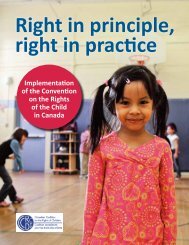Poste - Canadian Coalition for the Rights of Children
Poste - Canadian Coalition for the Rights of Children
Poste - Canadian Coalition for the Rights of Children
You also want an ePaper? Increase the reach of your titles
YUMPU automatically turns print PDFs into web optimized ePapers that Google loves.
Update<br />
• The Supreme Court <strong>of</strong> Canada recently instructed<br />
Immigration Canada that decisions made on<br />
humanitarian and compassionate grounds require<br />
“close attention to <strong>the</strong> interests and needs <strong>of</strong> children<br />
since children’s rights, and attention to <strong>the</strong>ir interests,<br />
are central humanitarian and compassionate values in<br />
<strong>Canadian</strong> society.”<br />
• A full discussion <strong>of</strong> issues affecting immigrant and<br />
refugee children can be found in <strong>the</strong> <strong>Coalition</strong>’s<br />
research paper on Article 22.<br />
Concern<br />
• fur<strong>the</strong>r measures seem needed to prevent and<br />
combat all <strong>for</strong>ms <strong>of</strong> corporal punishment and<br />
ill-treatment <strong>of</strong> children in schools or institutions<br />
and to protect <strong>the</strong> child from violence and abuse<br />
within <strong>the</strong> family<br />
Recommendation<br />
• review legislation to prohibit <strong>the</strong> corporal punishment<br />
<strong>of</strong> children by parents, schools and institutions and<br />
consider educational campaigns to help change societal<br />
attitudes about <strong>the</strong> physical punishment <strong>of</strong> children<br />
Update<br />
• There is no evidence that <strong>the</strong> federal government is<br />
considering <strong>the</strong> prohibition <strong>of</strong> corporal punishment.<br />
Section 43 <strong>of</strong> <strong>the</strong> Criminal Code allows parents and<br />
teachers to use “reasonable <strong>for</strong>ce” against children as a<br />
means <strong>of</strong> correction. This makes children <strong>the</strong> only<br />
persons in Canada who can be subject to physical<br />
assault without due process.<br />
• A full discussion <strong>of</strong> corporal punishment and child<br />
protection issues can be found in <strong>the</strong> <strong>Coalition</strong>’s<br />
research paper on article 19.<br />
Concern<br />
• need to protect children from harmful in<strong>for</strong>mation,<br />
especially television violence<br />
Update<br />
• Most <strong>Canadian</strong> children watch up to three hours <strong>of</strong><br />
television a day and this does not vary much according<br />
to age or income group. 11<br />
• A discussion <strong>of</strong> media literacy education can be<br />
found in <strong>the</strong> <strong>Coalition</strong>’s research paper on articles 28<br />
and 29, The Right to and Aims <strong>of</strong> Education.<br />
H O W D O E S C A N A D A M E A S U R E U P ?<br />
131<br />
Concern<br />
• increasing rate <strong>of</strong> youth suicide<br />
Update<br />
• The suicide rate <strong>for</strong> boys aged 15 to 19 was five per<br />
100,000 in 1960, 23 per 100,000 in 1991 and 18.5 per<br />
100,000 in 1996. 12 The suicide rate <strong>for</strong> girls is about<br />
one-quarter <strong>the</strong> boy’s rate but girls are hospitalized<br />
more frequently <strong>for</strong> attempted suicide. The rate among<br />
Aboriginal youth is about five times <strong>the</strong> national rate. 13<br />
Concern<br />
• lack <strong>of</strong> fundamental rights <strong>for</strong> vulnerable children,<br />
especially Aboriginal, including access to housing<br />
and education<br />
Recommendation<br />
• streng<strong>the</strong>n ef<strong>for</strong>ts to ensure vulnerable and<br />
disadvantaged groups better access to education and<br />
housing and research solutions to infant mortality and<br />
youth suicide in Aboriginal communities<br />
Update<br />
• Presently, social, economic and health indicators in<br />
Aboriginal communities are far below non-Aboriginal<br />
communities. The Aboriginal population is growing at<br />
twice <strong>the</strong> rate <strong>of</strong> <strong>the</strong> overall <strong>Canadian</strong> population. Twothirds<br />
<strong>of</strong> <strong>the</strong> Aboriginal population are under <strong>the</strong> age<br />
<strong>of</strong> 30, increasing <strong>the</strong> demand <strong>for</strong> Aboriginal children’s<br />
services. 14<br />
• The federal government announced an Aboriginal<br />
Action Plan in 1998 to streng<strong>the</strong>n Aboriginal<br />
governance, develop a new fiscal relationship and<br />
build strong communities. 15<br />
• There a number <strong>of</strong> federal programs serving<br />
Aboriginal children, such as <strong>the</strong> Head Start Initiative16 and <strong>the</strong> Community Action Program <strong>for</strong> <strong>Children</strong>, 17 but<br />
<strong>the</strong> existing services <strong>for</strong> vulnerable Aboriginal children<br />
do not meet <strong>the</strong> growing demand.<br />
Recommendation<br />
• use UNCRC as a framework <strong>for</strong> international<br />
development assistance<br />
Update<br />
• The <strong>Canadian</strong> International Development Agency has<br />
not articulated if or how it intends to use <strong>the</strong>




